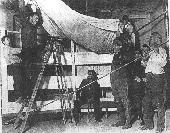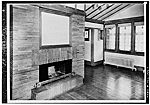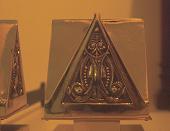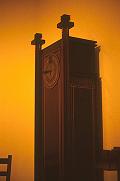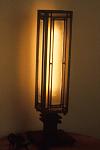|
|
|
Purcell and Elmslie, Architects Firm active :: 1907-1921
Minneapolis, Minnesota :: Chicago,
Illinois |
Ye Older Grindstones
9/20/2002
Steve Gregory supplements his earlier generous donation with a photograph of Francis Buzzell, one taken with Eugene O'Neill and his theater troupe no less, at the Provincetown Playhouse.
9/17/2002
Thanks go to Steve Gregory, a family genealogist whose ancestors included P&E residential client Francis Buzzell. Along with an account of Buzzell's life, Steve provided a copy of "Ma's Pretties," a short story published by the award-winning Buzzell in the 1910s.
9/15/2002
Babson estate plan, landscaping
HABS image, by Richard NickelStill working on the Babson estate. Added numerous images for the landscaping (by Jens Jensen), the decorative alterations, including the tall clock, undertaken at various times by P&E, and the later Service Buildings add to the estate in 1916. The Service Buildings are in the HABS records on the American Memory server at the Library of Congress web site, with photographs by Richard Nickel. I have been leery of adding a lot of external links to this site, because I know how frustrating it can be to find broken connections when you are on the trail. However, I have deposited the thumbnails locally, with both Images at U of M and LOC, so some continuity remains for researchers. That's going to have to do.
Andirons
Tall clockBack in the late 1970s and early 1980s, when I first encountered the calling for tangible objects beyond the Purcell Papers, I found great happiness in locating a set of the Babson house andirons and the tall clock (so-called "Grandchildren's clock") tucked away in the architecture gallery at the Chicago Art Institute. Timidly, I asked a guard if I could take a picture. "So long as you don't use a flash!" he replied. And so these are toasty golden brown, dimmed a bit from the presence, but still a luscious hint at the richness that was the interior of the Babson house. The clock originally had hands of solid gold, but when the Federal government decided private citizens could no longer own gold, Henry Babson replaced the Jarvie originals with black steel copies. Sigh.
9/14/2002
Henry B. Babson residence, 1914Added exterior photographs for the Chicago Edison Shop, and some views of the Babson house.
Of all the things that captured my imagination when I had the privilege of daily contact with the William Gray Purcell Papers, few were more compelling than the Lumiere autochromes taken by William Gray Purcell during 1914. Purcell used this new process to acquire color pictures of works by his firm (the Winona bank, the Powers house, and the Catherine Gray house, among others) and also some scenes at his family retreat in northern Wisconsin, Island Lake Camp. Only a few examples remain of an unknown number of originals. Some have decayed to mere black and white ghosts, and others are partially invisible. One or two are cracked or fragmentary. The best of one of all, however, is the above image of the Henry B. Babson residence. This magnificent dwelling was demolished in 1960, and this color view was taken just after P&E enclosed the sleeping porch.
9/13/2002
Light fixture, Minnesota Photograph Company
Upholstered sofa and chair
Added some Parabiographies entries [Commission list 135-138], links to Wakefield photographs, plus more drawings for the Meyers, Moore, and Cross residence projects, and some new pictures of the Minnesota Phonograph Company, an Edison Shop that was located in Minneapolis.
I looked in the window of what remained of Minnesotan Edison establishment in the early 1980s, just before the city entire block was brought down to construct the City Center mall and office complex. Alan Lathrop pointed store front out to me, on one of those very rare occasions when we walked together on the streets of downtown. Nothing was left, really, except the barest outline of the raw floor plan. Certainly all of the light fixtures and ornament were long gone. The furniture left with Lawrence Lucker, the P&E client and proprietor of the establishment, when he closed the store in the 1930s. Lucker sold or gave some of the furniture to David Gebhard in the 1950s, including one of the two leaded glass light fixtures that rested on the decorative wooden grille screens toward the front of the sales room (shown above). Gebhard acquired the sofa and upholstered side chair, too. He told me that he lent the suite, complete with formal loan agreement, to the Faculty Club at UC-Santa Barbara, during the 1970s. The Club, however, chose to redecorate at some point without notice to or by Gebhard, and apparently the persons in charge chucked out this P&E historic piece of furniture in favor of something newer. We can only hope that some wise eye went dumpster diving, and somewhere out in the world this elegant furniture still exists somewhere other than the landfill.
9/11/2002
Remember.
9/8/2002
Added the Hirschfelder house project, including the Parabiographies entry. Restructuring the web directory, too, to overcome the lengthy waits involved with FrontPage now that this site has grown so large. Tick, and a grinding tock, to get even the simplest hyperlink in place. Let's see if performance is coachable.
For those who are interested in the living evolution of organic architecture, I suggest a visit to the website of Arthur Dyson, AIA, FARA (opens new browser window). Dyson was Purcell's last apprentice, and was among the final ones of Frank Lloyd Wright. Over the past 35 years, Art Dyson encountered many of the same problems as P&E, and came up with some wonderfully fresh responses in his designs. There are parallels in his small houses to the programs followed in P&E's various low cost solutions, though the forms are naturally different. And in the Charles Hilton residence now under construction in Florida, Dyson shows what he can do with a full economic palette, just as George Elmslie did for Charles R. Crane or Henry B. Babson. Architecture grows still...

